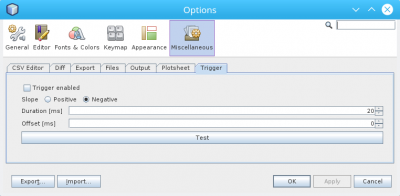Inhaltsverzeichnis
Trigger
The original Trigger-API functionality is used to create a puls to signal start and/or stop of a measurement/trial. The slope and the duration of the signal can be configured in the options menu.
Furthermore there are additional methods to control external systems in a more complex process, e.g. waiting that an external system is ready (nextCycle()).
Trigger SPI
Multiple implementations of the following SPI are possible and can be used to adjust to external systems:
package de.orat.dataaquisition.measurementsystem.spi; import de.orat.motionData.PropertyGroup; import java.util.concurrent.ExecutionException; /** * @author Oliver Rettig */ public interface iTrigger { /** * Initialisation of the trigger implementation functionality. * * This method is invoked, befor recording is started with the trial type the trigger * is configured and * - if the trigger functionality is activated in the trigger options panel * - maybe further explicitly by an init-button in the trigger options panel. * * @param configuration * @return false, if the initialisation failed */ public boolean init(PropertyGroup configuration); /** * Get the name of the trigger. * * This name is also used as a configuration property group name. * * @return name of the trigger implementation */ public String getName(); public void dispose(); /** * Set the signal, which is used to control start triggering. * * Generally this method is used to create a signal with a defined duration * and slope. To do this this method is invoked twice in a short distance * with the oppositite parameter value.<b> * * But a specific implementation e.g. ROSTrigger can implement this method to * do something else, e.g. using the first invocation to invoke an RPC and ignoring * the second invocation.<b> * * @param on true, to set the signals bit to 1, else 0. */ public void startTriggerSignal(boolean on); /** * Set the signal, which is used to control stop triggering. * * Can be used to define the end of a measurement process for variable length * recording. * * Currently only used by the QuancomIOTrigger implementation as WORKAROUND. * * @param on */ public void stopTriggerSignal(boolean on); /** * Waiting until starting next cycle is possible. * * @return properties of the next cycle or null if waiting is failed. * @throws ExcecutionExceptin if nextCycle fails fatal an the recording must be stopped. */ public PropertyGroup nextCycle() throws ExecutionException; /** * * Used to close a robot program before loading a new one. * * @return * */ public boolean close(); }
Implementing the nextCycle()-method allows to ask for an external system to be ready before starting the measurement of the next trial in multicycle recordings.
Configuration of trigger implementations
A trigger implementation is used only, if it is included in a trial type. To do this a property group with the name of the trigger must be included into the trial type configuration. This property group can include implementation specific properties to config the trigger.
... <TrialType name="takeover" duration="2" labelset="Input.xml" measurementSystemConfigIds="default"> <PropertyGroup name="ROSTrigger"> <!-- ROS trigger specific properties--> <Property name="robot_cmd_node_name" value="robot_command_server"/> <Property name="robot_cmd_service_name" value="robotCommand"/> <Property name="nextcycle_cmd_node_name" value="robot_nextcycle"/> <Property name="nextcycle_cmd_service_name" value="nextCycle"/> </PropertyGroup> ...
It is possible to use more than one trigger for a trial type.
Generic Options of the triggering functionality
Generic configuration of the trigger functionality can be done via the options dialog in the misceleanous tab.

| Property name | Description | Unity |
|---|---|---|
| Duration | If startTrigger is used to create a signal, duration defines the width of the signal, can be 0 else. | [ms] |
| Slope | If startTrigger is used to create a signal the slope value defines if a positive or negative signal is created. A positive signal is create if slope is set to true. | - |
| Offset | Can be used to delay the start of the trigger. | [ms] |
